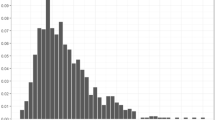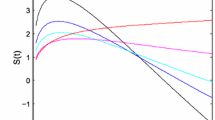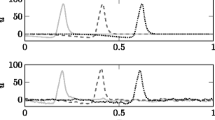Abstract
The temporal patterns of action potentials fired by a two-point stochastic neuron model were investigated. In this model the membrane potential of the dendritic compartment follows the Orstein-Uhlenbeck process and is not affected by the spiking activity. The axonal compartment, corresponding to the spike initiation site, is described by a simplified RC circuit. Estimators of the mean and variance of the input, based on a sampling of the axonal membrane potential, were derived and applied to simulated data. The dependencies of the mean firing frequency and of the coefficient of variation and serial correlation of interspike intervals on the mean and variance of the input were also studied by computer simulation in both 1- and 2-point models. The main property distinguishing the 2-point model from the classical 1-point model is its ability to produce clusters of short (or long) intervals between spikes under conditions of constant stimulation, as often observed in real neurons. It is shown that the nearly linear frequency response of the neuron, starting with subthreshold values of the input, is accounted for by the variability of the input (noise), which indicates that noise can play a positive role in nervous systems. The linear response frequency with respect to noise of the models suggests that the neuron can function as a noise encoder.
Similar content being viewed by others
Explore related subjects
Discover the latest articles and news from researchers in related subjects, suggested using machine learning.References
Abeles M (1991) Corticonics. Neural circuits of the cerebral cortex. Cambridge University Press, Cambridge, UK.
Adrian ED (1926) The impulses produced by sensory nerve endings. J Physiol (Lond) 61:49–72.
Berger DH, Pribram KH (1992) The relationship between the Gabor elementary function and a stochastic model of the inter-spike interval distribution in the responses of visual cortex neurons. Biol Cybern 67:191–194.
Gerstner W, Hemmen JL van (1992) Universality in neural networks: the importance of the ‘mean firing rate’. Biol Cybern 67:195–205.
Gummer AW (1991a) Postsynaptic inhibition can explain the concentration of short inter-spike intervals in avian auditory nerve fibres. Hearing Res 55:231–243.
Gummer AW (1991b) Probability density function of successive intervals of a nonhomogeneous Poisson process under low-frequency conditions. Biol Cybern 65:23–30.
Habib MK, Thavaneswaran A (1990) Inference for stochastic neuronal models. Appl Math Comput 38:51–73.
Kenyon GT, Puff RD, Fetz EE (1992) A general diffusion model for analyzing the efficacy of synaptic input to threshold neurons. Biol Cybern 67:133–141.
Kohn AF (1989) Dendritic transformations on random synaptic inputs as measured from a neuron's spike train — modeling and simulation. IEEE Trans Biomed Eng 36:44–54.
Lánská V, Lánský P, Smith CE (1994) Synaptic transmission in a diffusion model for neural activity. J. Theor Biol 166:393–406.
Lánský P (1983) Inference for the diffusion models of neuronal activity. Math Biosci 67:247–260.
Lánský P (1984) On approximations of Stein's neuronal model. J Theor Biol 107:631–647.
Lánský P, Lánská V (1994) First-passage-time problem for simulated stochastic diffusion processes. Comput Biol Med 24:91–101.
Lánský P, Rospars JP (1993) Coding of odor intensity. BioSystem 31:15–38.
Lánský P, Giorno V, Nobile AG, Ricciardi LM (1988) A diffusion neuronal model and its parameters. In: Ricciardi LM (ed) Biomathematics and related computational problems. Kluwer, Dordrecht.
Levine MW (1991) The distribution of the intervals between neural impulses in the maintained discharges of retinal ganglion cells. Biol Cybern 65:459–467.
Levine MW (1992) Modeling the variability of firing rate of retinal ganglion cells. Math Biosci 112:225–242.
Longtin A, Bulsara A, Pierson D, Moss F (1994) Bistability and the dynamics of periodically forced sensory neurons. Biol Cybern 70:569–578.
Pacut A, Dabrowski L (1988) Delayed-exponential approximation of a linear homogeneous diffusion model of neuron. Biol Cybern 59:395–404.
Perkel DH, Bullock TH (1968) Neural coding. Neurosci Res Prog Bull 6:221–350.
Ricciardi LM, Sacerdote L (1979) The Ornstein-Uhlenbeck process as a model of neuronal activity. Biol Cybern 35:1–9.
Ricciardi LM, Sato S (1990) Diffusion processes and first-passage-time problems. In: Ricciardi LM (ed) Lectures in applied mathematics and informatics. Manchester University Press, Manchester.
Rospars JP, Lánský P (1993) Stochastic model neuron without resetting of dendritic potential. Application to the olfactory system. Biol Cybern 69:283–294.
Rospars JP, Lánský P, Vaillant J, Duchamp-Viret P, Duchamp A (1994) Spontaneous activity of firstand second-order neurons in the frog olfactory system. Brain Res 662:31–44.
Smith CE (1992) A heuristic approach to stochastic models of single neurons. In: McKenna T, Davis J, Zornetzer SF (eds) Single neuron computation. Academic Press, Boston.
Stein RB (1965) A theoretical analysis of neuronal variability. Biophys J 5:173–195.
Tuckwell HC (1988) Introduction to theoretical neurobiology. Cambridge University Press, Cambridge, UK.
Tuckwell HC, Richter W (1978) Neuronal interspike time distributions and the estimation of neurophysiological and neuroanatomical parameters. J. Theor Biol 71:167–180.
Yu X, Lewis ER (1989) Studies with spike initiators: linearization by noise allows continuous signal modulation in neural networks. IEEE Trans Biomed Eng 36:36–43.
Author information
Authors and Affiliations
Rights and permissions
About this article
Cite this article
Lánský, P., Rospars, J.P. Ornstein-Uhlenbeck model neuron revisited. Biol. Cybern. 72, 397–406 (1995). https://doi.org/10.1007/BF00201415
Received:
Accepted:
Issue Date:
DOI: https://doi.org/10.1007/BF00201415




